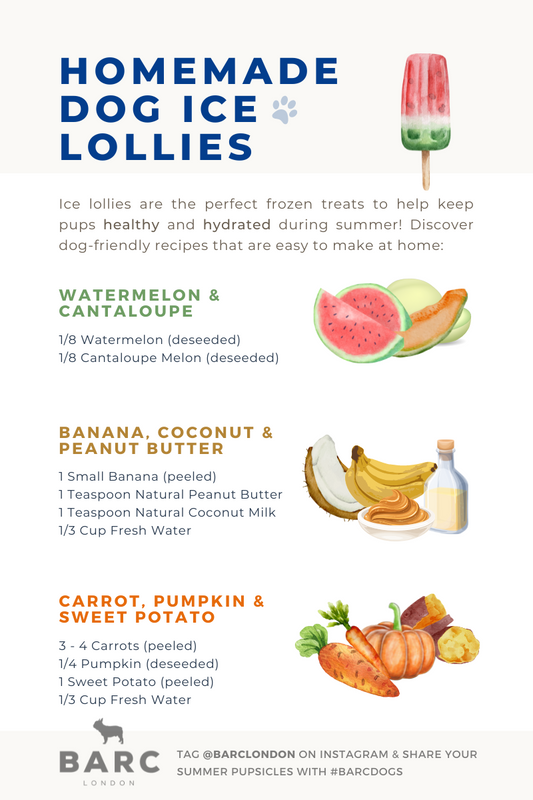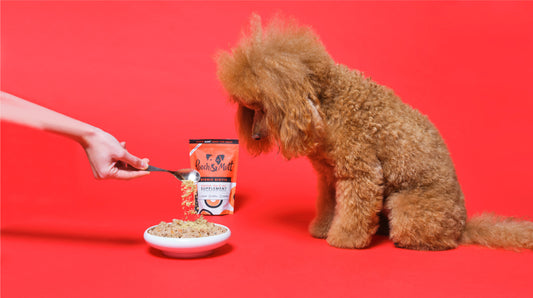Now that summer is officially here, with parts of the UK already having experienced the hottest day of the year so far, most pet parents will be doing everything they can to keep their dogs cool and as comfortable as possible.
As the temperatures increase, you may start to notice a few differences in your dog's behaviour. Not only are they likely to be a little more subdued than usual, but you may find your dog’s eating habits starting to change.
That once empty bowl might stay fuller for longer, or your pup might not seem as excited for feeding time as they usually are.
In these instances, you might be wondering whether this behaviour is normal or a cause for concern. To help with this, we’ve put together some insights and a few useful feeding tips to consider on warmer days:
- Do dogs lose their appetite in summer?
- Why do some dogs eat less in warmer weather?
- Is it something I should be worried about?
- Feeding tips for warm weather:

Do dogs lose their appetite in summer?
During the hot summer months, you may start to notice your pup not licking their bowl clean like they normally would. Or you might find they don’t want to eat much food at all when the weather gets hot.
As concerning as this can be for any dog owner, a reduced appetite during summer months is very normal and not necessarily something to worry about.
When the weather is warmer, there are a few reasons why dogs tend to have less of an appetite. Keep reading to find out more.
Why do some dogs eat less in warmer weather?
1. Light levels ☀️
As crazy as this may sound, brighter days with increased solar light can cause a dog to eat less food.
Many mammals naturally reduce their food intake when there are more hours of sun during the day.
Their metabolism is no longer accelerated by triggers from their endocrine system, like it is during winter months, when the need to store nutrients is prominent and innate.
2. Higher temps 🌡️
As the heat builds, there may be days when you notice you’ve hardly eaten anything, with the thought of food not even crossing your mind.
This is normal for our dogs too and they will likely become less active and fatigue more easily.
Your pup will probably prioritise drinking water over eating meals during warm weather days, as they will be panting a lot more than normal so need it to cool themselves and help regulate their body temperature.
3. Less active 🐕
As mentioned above, most dogs are a lot less active during the summer months, so don’t be alarmed if their overall behaviour is more subdued.
Because of this, they need fewer calories to keep themselves going, and with an increase in panting adding to their fatigue, the need for high calories to fuel their energy levels is therefore reduced.
4. Illness 🤢
It is worth keeping in mind that sometimes a dog's loss of appetite may be linked to sickness or problems with their teeth, and this is most likely the case if you notice any other symptoms at the same time.
More often than not, it won't be linked to a serious disease, but it is worth speaking to your vet if you’re concerned just to make sure!
Regular checks are always advisable, and there’s no harm ruling things out, particularly during the hot weather.
5. Discomfort 🥵
As mentioned above, dogs might find it harder to eat their meals when they are uncomfortably hot and busy expending energy trying to stay cool. Because of this, it’s important to try to make sure your dog has a cool place to enjoy their food.
If you find that your home gets very hot during the day, it might be a good idea to get a fan to help your dog stay cool - particularly after summer walks! More indoor ventilation or air conditioning will help your dog regulate their temperature and eat peacefully.
With this in mind, you should also make sure your dog’s food isn’t left out too long in the heat. Hot temperatures can cause bacteria to grow quickly and make food go bad, potentially resulting in an upset tum!

Is it something I should be worried about?
Generally speaking, if your dog is eating less during warmer months it’s not something you need to worry about.
However, if your dog is refusing to eat altogether then this can be a cause for concern and you should contact your vet.
Sometimes, it may be as simple as a little nausea or a dental infection, but it could also be the sign of something more serious.
With the worry of heat stroke dominating most pet parent’s minds, it’s important to stay vigilant and look out for other signs of overheating - such as vomiting and diarrhoea, alongside their refusal to eat.
Aside from the increase in temperature and illness, other reasons for reduced eating include:
- Recent vaccinations: Certain shots can cause a loss of appetite
- Unfamiliar surroundings: This could be if you’re on a dog friendly summer holiday, they’re spending the night with family/friends, or you’ve moved house and they’re still settling in
- High pressure situations: May cause dogs to feel stressed or anxious, making it harder for them to comfortably digest food
- Fussy eaters: Sometimes the root cause may simply be down to pickiness or behavioural issues
- Old age: Senior dogs tend to have less of an appetite than puppies, adolescents and adults
Dog feeding tips for warm weather
From reducing the size of your dog’s meals, opting to hand feed throughout the day, or changing to a wet food over the hot summer months, if you start to notice your dog’s appetite is decreasing, there are several things you can try to ensure they’re still getting the correct nutrition.
Adjust meal times ⏰
Within a 24 hour period, vets recommend dogs to eat at least two meals a day twelve hours apart.
However, meal time might be the last thing on your pup's mind when it’s warm - they’ll be focused on trying to stay cool and rehydrating themselves instead.
If this is the case, you could try and feed your dog at a different time of day, opting for early morning or late evening when the temperature is cooler.
Switch up their food 🍴
If your dog has dry food for dinner, it may be worth switching things up during the summer months to see if that helps.
You could try adding a little water to their food as this will increase their water consumption, or you could make the switch to wet food by reducing their biscuit allowance and topping it with a tasty topper.
If you’re unsure on the correct quantity of dog food to feed them, consult your vet for their recommendations.
Keep their water bowl topped up 💧
It’s always good to make sure your pup is getting enough water throughout the day, but this becomes increasingly important on hot days.
Because they don’t sweat like us, they’ll be panting a lot more than usual to regulate their temperature, and therefore they’ll need to drink more to replace fluids.
Try frozen treats 🧊
Have some fun with the freezer and test out making cooling treats for your dog to enjoy. They’re super easy to make, and often include 3 ingredients or less!
Whether you choose to fill an ice cube tray or a plastic container with their favourite dog safe fruit and veg, shredded chicken, or a selection of toys, the choice is yours.
You could also try freezing some salt-free chicken soup to increase their food intake.
Stay up to date with Heat-Health Alerts 📈
From 1st June to 15th September, the Met Office releases alerts when UK temperatures pass certain heat thresholds.
These warnings help health professionals minimise the impact of extreme temperatures on people's health, but can also be used to preempt hot weather for pups too.


